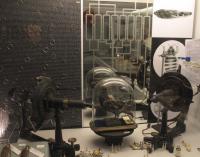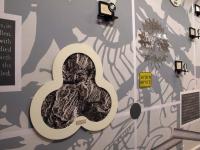Posted on December 9, 2009

As an artist, I have, for many years been interested in the manner in which visual codes prescribe the understanding and reception of various disciplines. Bio-medical representation is one of these fertile areas and my current exhibition, Subtle Thresholds at the Iziko South African Museum, Cape Town, explores the representational taxonomies of disease. This is a term more often used in computer programming, but in this instance, I take it to refer to the politicised visual ordering of the medical body.

Subtle Thresholds, rests on the belief that active curatorship is able to dislodge previous patterns of viewing and understanding, and that through finely orchestrated relationships objects can sound, if not speak, independently of any authoritative text. It makes reference to Linnaean taxonomy and cladistics, yet uses a lattice of conceptual and visual cross-referencing to undermine this oppositional understanding of species. It co-opts layering and repetition of form through visual 'hyperlinks' to expose the interconnectivity between organisms, world-views and mythologies and the layout evokes a cosmology - a scattering of objects and images. In acknowledging the history of the relationships between images and text and museums and text, this project attempts to disaggregate object and image from text and label, allowing for a sensorial apprehension of the material alongside a more traditional reading of details within it.
In order to disrupt the stigma and fear typically associated with disease, the exhibition co-opts beauty and wonder as visual strategies. Scanning Electron Microscope images of animal faeces – the ultimate feared site of contamination – become beguiling landscapes and viral diagrams constructed from pharmacological lab-ware become magical mandala-like cityscapes. In disrupting the typical associations with disease as a site of ugliness and fear, the intention has been to facilitate a point of contact that promotes further discussion or investigation.

The project is conscious of the politics of exclusion within medical discourse, and itself provides limited access to text. The scale and height of the framed, index card myths make them unreadable, despite the provision of a magnifying glass; explanatory texts in the cabinets thwart analysis as they lose their numbering system and direct references; and animal specimens are only labeled by the diseases which they carry. Timelines are a device used to provide orientation and guidance, yet they often present a decontextualised chronology - the chosen inclusions often reflecting relationships of power. In this exhibition, the 'timeline' is in the form of a ruler, circumscribing 68 metres and including a biblical concordance of disease, literally running counter to a more conventional microbial history. The ruler measurements are indicated by a chordate species list, incrementally divided by microbial species in red. This is makes up one part of the encyclopaedic inventory of the exhibition that, in its visual complexity, creates a sense of disorientation. The system of cross-referencing necessitates an active (and physical) engagement with the layout of the exhibition in a search for linkages. Knowledge acquisition here is a discovery that requires participation.

The exhibition runs until March 2010 and is to be seen at the Iziko South African Museum.
25 Queen Victoria Street, Cape Town.
Ph 021 481 3800
www.iziko.org.za